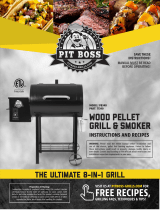
ENGLISH
3
6. Parts of the barbecue may be very hot, and serious injury may occur. Keep young children and pets away while in use.
7. Do not enlarge igniter holes or burn pots. Failure to follow this warning could lead to a fire hazard and bodily harm and will
void your warranty.
8. Product may have sharp edges or points. Contact may result in injury. Handle with care.
DISPOSAL OF ASHES
Ashes should be placed in a metal container with a tight-fitting lid. The closed container of ashes should be placed on a non-
combustible floor or on the ground, well away from all combustible materials, pending final disposal. When ashes are disposed by
burial in soil, or otherwise locally dispersed, they should be retained in a closed container until all cinders have thoroughly cooled.
WOOD PELLET FUEL
This pellet cooking appliance is designed and approved for pelletized, all natural, wood fuel only. Any other type of fuel burned in
this appliance will void the warranty and safety listing. You must only use all natural wood pellets, designed for burning in pellet
barbecue grills. Do not use fuel with additives. Wood pellets are highly susceptible to moisture and should always be stored in an
airtight container. If you are storing your grill, without use, for an extended period, we recommend clearing all pellets from your
grill's hopper and auger, to prevent jams. The pellet fuel mean heating value in 8000-8770 BTU/LB, ash content < 1%.
Do not use spirit, petrol, gasoline, lighter-fluid or kerosene for lighting or refreshing a fire in your grill.
Keep all such liquids well away from the appliance when in use.
At this time, there is no industry standard for barbecue wood pellets, although most pellet mills use the same standards to make
wood pellets for domestic use. Further information, can be found at
www.pelletheat.org
or the
Pellet Fuel Institute
.
Contact your local dealer on the quality of pellets in your area, and for information on brand quality. As there is no control over
the quality of pellets used, we assume no responsibility to damage caused by poor quality of fuel.
CREOSOTE
Creosote, or soot, is a tar-like substance. When burning, it produces black smoke with a residue which is also black in color. Soot
or creosote is formed when the appliance is operated incorrectly, such as: blockage of the combustion fan, failure to clean and
maintain the burn area, or poor air-to-fuel combustion.
It is dangerous to operate this appliance should the flame become dark, sooty, or if the burn pot is overfilled with pellets. When
ignited, this creosote makes an extremely hot and uncontrolled fire, similar to a grease fire. Should this happen, turn the unit OFF,
let it cool completely, then inspect for maintenance and cleaning. It commonly accumulates along exhaust areas.
If creosote has formed within the unit; allow the unit to warm up at a low temperature, turn off the appliance, then wipe away
any formation with a hand towel. Similar to tar, it is much easier to clean when warm, as it becomes liquid.
CARBON MONOXIDE (“ ”)
Carbon monoxide is a colorless, odorless, tasteless gas produced by burning gas, wood, propane, charcoal or other fuel. Carbon
monoxide reduces the blood’s ability to carry oxygen. Low blood oxygen levels can result in headaches, dizziness, weakness,
nausea, vomiting, sleepiness, confusion, loss of consciousness or death. Follow these guidelines to prevent this colorless, odorless
gas from poisoning you, your family, or others:
• See a doctor if you or others develop cold or flu-like symptoms while cooking or in the vicinity of the appliance. Carbon
monoxide poisoning, which can easily be mistaken for a cold or flu, is often detected too late.
• Alcohol consumption and drug use increase the effects of carbon monoxide poisoning.
Carbon monoxide is especially toxic to mother and child during pregnancy, infants, the elderly, smokers, and people with blood
or circulatory system problems, such as anemia, or heart disease.




























